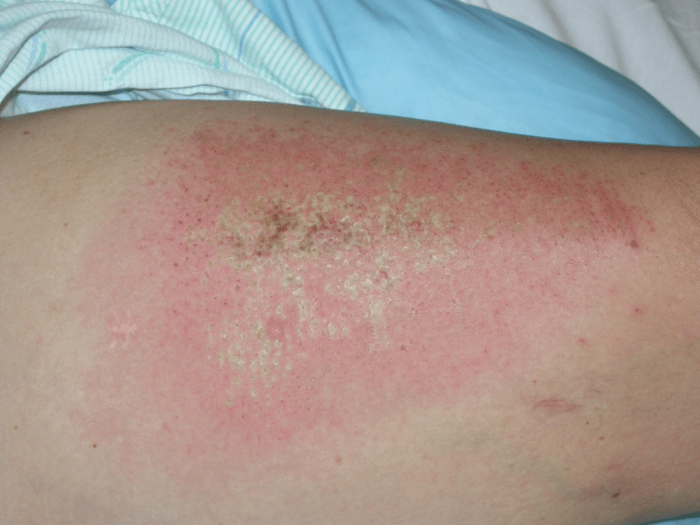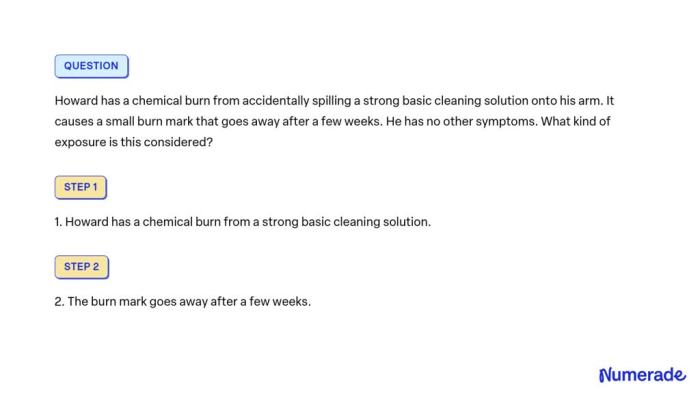Howard has a chemical burn from accidentally spilling – Howard’s chemical burn from accidentally spilling has brought to light the critical importance of understanding chemical burns, their causes, and the appropriate treatment options. This comprehensive guide delves into the complexities of chemical burns, empowering individuals with the knowledge to prevent, treat, and mitigate their potential hazards.
Chemical burns, unlike thermal burns, are caused by contact with corrosive substances, resulting in a wide range of injuries depending on the severity and extent of exposure. Understanding the different types of chemical burns, the agents that cause them, and the chemical reactions involved is essential for effective management.
Overview of Howard’s Chemical Burn: Howard Has A Chemical Burn From Accidentally Spilling
Howard sustained a chemical burn while working in a laboratory. He accidentally spilled a concentrated acid solution on his arm, causing severe damage to the skin and underlying tissues. Immediate first aid measures were taken to neutralize the acid and prevent further injury.
The burn was classified as a second-degree chemical burn, characterized by blistering, swelling, and intense pain. The affected area was approximately 10 centimeters in diameter and extended from the elbow to the wrist.
Types and Causes of Chemical Burns

Chemical burns are classified based on the severity and type of chemical involved.
Types of Chemical Burns
- Acid burns: Caused by contact with strong acids, such as hydrochloric acid or sulfuric acid.
- Alkali burns: Caused by contact with strong alkalis, such as sodium hydroxide or potassium hydroxide.
- Oxidizing burns: Caused by contact with oxidizing agents, such as hydrogen peroxide or bleach.
- Vesicant burns: Caused by contact with blistering agents, such as mustard gas or lewisite.
Causes of Chemical Burns, Howard has a chemical burn from accidentally spilling
Chemical burns can be caused by exposure to various agents, including:
- Industrial chemicals
- Household cleaners
- Laboratory reagents
- Agricultural chemicals
Chemical Reactions Involved
Chemical burns occur when the chemical agent reacts with the skin and underlying tissues. Acid burns cause denaturation of proteins and coagulation necrosis, while alkali burns cause liquefactive necrosis. Oxidizing burns release free radicals that damage cell membranes and DNA.
Treatment Options for Chemical Burns

Treatment for chemical burns depends on the severity and type of burn.
Primary Treatment Methods
- Immediate Irrigation:Copious amounts of water or saline solution are used to flush the affected area and neutralize the chemical.
- Chemical Neutralization:Specific neutralizing agents, such as sodium bicarbonate for acid burns or acetic acid for alkali burns, are applied to the wound.
- Wound Debridement:Removal of dead and damaged tissue to promote healing.
Potential Complications
Chemical burns can lead to various complications, including:
- Infection
- Scarring
- Contractures
- Systemic toxicity
- Proper handling and storage of hazardous chemicals
- Use of personal protective equipment (PPE), including gloves, goggles, and respirators
- Training on chemical handling and emergency response
- Store household cleaners and chemicals out of reach of children
- Read and follow instructions carefully
- Use proper ventilation when using strong chemicals
Prevention and Safety Measures

Preventing chemical burns requires implementing proper safety measures.
Workplace Safety
Household Safety
FAQ Corner
What are the different types of chemical burns?
Chemical burns are classified into three types: acid burns, alkali burns, and vesicant burns.
What are the immediate first aid measures for chemical burns?
Immediately flush the affected area with copious amounts of water for at least 15 minutes. Remove contaminated clothing and jewelry. Seek medical attention promptly.
What are the potential complications associated with chemical burn treatment?
Complications may include infection, scarring, contractures, and long-term tissue damage.